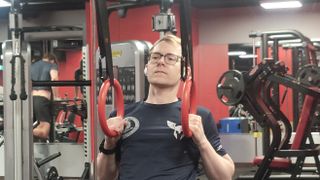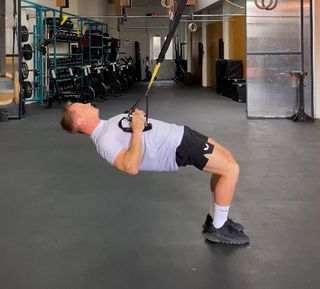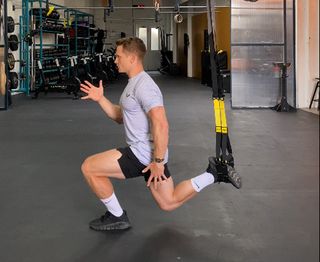How this cheap piece of fitness kit helped me stay in shape for a year
Suspension trainers are a cheap, portable, low-impact home gym

There’s no doubt about it: keeping fit can be expensive. If you’re a runner, you’re going to want to replace your running shoes after a year or two of hard use. If you’re a lifter, you might invest in a set of dumbbells and even a barbell if you have space, or commit to a monthly gym membership.
Surfer? Board, wax, and expensive surf trips if you don’t live near the sea. Climber? Forget about it. Cyclist? Bikes are fun, but they’re not the cheapest hobby. In all cases, getting one of the best fitness trackers or smartwatches will also be on your list, as it’s a great way to monitor your activity.
However, while the above pursuits can get pricey, many people are just looking for a way to stay active and healthy without breaking the bank. If you’re hesitant about committing to a monthly gym membership and just after a cheap bit of kit to help you stay fit at home, I have a recommendation for you: suspension trainers, such as the TRX or Olympic gymnastics rings, can do the job for less.
When COVID hit in 2020 and all the gyms closed, like many others, my usual fitness routine was thrown out of balance. We were all stuck at home, and unless you had the money and space for a comprehensive home gym setup, resistance training was very difficult to do. After discovering a sturdy tree in my local park, I bought a set of gymnastics rings from Amazon for £35, around US$40 or AUS$62, and it was the best money I spent throughout the pandemic.
These rings could be fastened to a horizontal bar or tree branch, allowing me to work out my entire body in different ways by redistributing my weight to hit multiple muscle groups. If I didn’t have the facility of the park nearby, I would have invested in an indoor suspension trainer like the ones from the TRX Training line, which comes complete with a door hook and starts from around £80 in the UK, US$125 in the US and AUS$145 in Australia. However, off-brand suspension trainers can be bought on Amazon for far less.
It was like a full home gym had opened up in front of me. I could lean backward, gripping the rings and pulling myself towards the tree in an inverted row. This exercised my biceps and back muscles, which allowed me to eventually graduate to more reps during my pull-ups.
For my chest and triceps, I could complete incline push-ups or adjust the rings higher and do tricep dips. For my legs, I could lengthen the strap and do split squats, placing one foot behind me in the ring while I lowered myself down to the ground on one leg, and back up again.
Get daily insight, inspiration and deals in your inbox
Get the hottest deals available in your inbox plus news, reviews, opinion, analysis and more from the TechRadar team.
The rings made things extra challenging as I fought to keep the wobbly straps in place, which is great for your core. Research has found performing strength training using an unstable surface, such as the straps, increases muscle activation compared to performing the exercises with more stability. It's also a low-impact fitness solution with easily-adjustable difficulty levels, so it's a great tool for beginners.
The rings were a game-changer for my training in every way. When I started, I was a keen runner, but my upper-body strength was lacking a little: on a good day, I could do around four neutral-grip pull-ups in a row. Twice a week for around eight months, I would go to the park to train by doing inverted rows, dips, assisted squats, and more. In November that year, I completed my first full set of 10 pull-ups, a fitness milestone in every way.
How to get started using a suspension trainer
If you don’t have a gym accessible, suspension trainers are cheaper and more portable than a set of adjustable dumbbells, and you can end up graduating to do some truly impressive calisthenics moves.
If you've got a suspension trainer with a simple door hook, then you have a portable home gym you can just roll up and take in a bag wherever you go.
Don’t know where to start? Expert TRX Training Club instructor Tom Cuff-Burnett has supplied step-by-step guides to a trio of basic suspension training moves. Check them out below:
Olympic Ring Push-Up

An excellent alternative to, or progression of, the traditional push-up, which tests your shoulder and core stability to the max.
- Start with straight arms and hold the rings with your knuckles facing the floor in a strong ‘punch’ position, before extending the legs out into a plank.
- Slowly take your hands apart and lower your chest between the rings until it is in line with your hands.
- Press away from the floor and bring the arms back to shoulder width apart.
TRX Inverted Row

A great way to develop the large muscles in the back and improve posture.
- Adjust your straps so the rubber handles are sitting just below the hip. Facing your anchor point, lean back and walk your feet all the way forward until they are directly underneath it (or against the door if you’re using the door anchor).
- Bend the knees and squeeze your glutes to bring your body into a flat line.
- Initiate the movement by pulling your chest up towards the straps and squeezing your shoulder blades together, finishing with your hands either side of your rib cage.
- Return to the bottom position, making sure to keep the core and glutes engage throughout.
TRX Suspended Lunge

The perfect test of lower body stability and strength, this move will also help uncover and address any imbalances you may have.
- Adjust your straps so the rubber handles are at your kneecaps, then place one foot into both foot cradles.
- Facing away from your anchor point, slowly bend the front leg until your back knee gently touches the floor behind you (both legs at approximately 90°).
- Drive through the heel on the front leg to return to standing.

Matt is TechRadar's expert on all things fitness, wellness and wearable tech. A former staffer at Men's Health, he holds a Master's Degree in journalism from Cardiff and has written for brands like Runner's World, Women's Health, Men's Fitness, LiveScience and Fit&Well on everything fitness tech, exercise, nutrition and mental wellbeing.
Matt's a keen runner, ex-kickboxer, not averse to the odd yoga flow, and insists everyone should stretch every morning. When he’s not training or writing about health and fitness, he can be found reading doorstop-thick fantasy books with lots of fictional maps in them.
